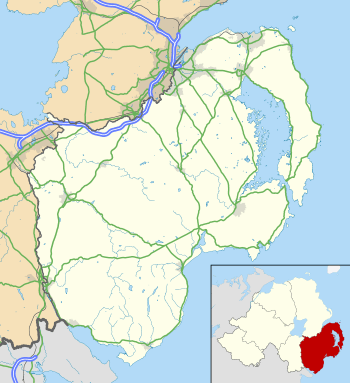Dundrum, County Down
Dundrum (from Irish: Dún Droma, meaning "fort of the ridge")[1][2] is a village and townland in County Down, Northern Ireland. It is beside Dundrum Bay, about 4 miles outside Newcastle on the A2 road. The village is best known for its ruined Norman castle. It had a population of 1,555 people at the 2011 Census.
Dundrum
| |
|---|---|
 | |
 Location within County Down | |
| Population | 1,065 (2001 Census) |
| District | |
| County | |
| Country | Northern Ireland |
| Sovereign state | United Kingdom |
| Post town | NEWCASTLE |
| Postcode district | BT33 |
| Dialling code | 028 |
| UK Parliament | |
| NI Assembly | |
History
Norman times
In 1177, the Normans, who had conquered great swathes of Ireland, invaded eastern Ulster and captured territories along its coast. John de Courcy, who had led the invasion, began building Dundrum Castle in the early 13th century on top of an earlier Gaelic fort. The castle was to guard the land routes from Drogheda to Downpatrick. In 1203, de Courcy was expelled from Ulster by fellow Norman Hugh de Lacy, 1st Earl of Ulster. Two years later, de Courcy tried to re-take the castle but failed. It was visited by King John in 1210, who spent money for minor works to the castle and paid for a garrison there.
15th Century
Dundrum castle was held by the Earls of Ulster until the 15th century, it was captured by the Magennises of Mourne, a Gaelic clan. In 1517, the Earl of Kildare briefly captured the castle, as did the Lord Deputy Leonard Grey, 1st Viscount Grane in 1538. The castle was surrendered to the English Crown in 1601 by Phelim Magennis, granted to Edward Lord Cromwell and sold to the Blundell family. The Magennises re-took the castle during the Irish Confederate Wars/Eleven Years' War (1641-1653) but lost it to the Parliamentarians ("Roundheads") of the contenders versus the Cavaliers of King Charles I in the simultaneous English Civil War. The Blundells returned after the civil war during the Restoration of the Monarchy and built the house on the south edge of the castle.
17th Century
In the 17th century, Ulster's ports began to rise in prominence. In 1625 William Pitt was appointed as Customer of the ports of Newcastle, Dundrum, Killough, Portaferry, Donaghadee, Bangor and Holywood.[3] Coal was a major import into Dundrum, where the East Downshire Steamship Company was based. Dundrum was a commercial port until 1984.
SS Great Britain

.jpg)
The SS Great Britain, one of the first iron ships and designed by Isambard Kingdom Brunel, was on its way from Liverpool to New York in 1846, when it ran aground in Dundrum Bay during bad weather. The captain, James Hosken, miscalculated the steamer's speed, and with poor charts, mistook the St John's Point lighthouse for the Chicken Rock lighthouse. It took a year to re-float the ship but it continued in use for many years. It is now a visitor attraction in Bristol.
Transport
Dundrum railway station was opened by the Belfast & County Down Railway on 25 March 1869 and operated until 16 January 1950.[5]
Sport
Dundrum Cricket Club plays in the NCU Senior League. Dundrum also has a Gaelic football club whose senior men play in Down‘s division 4 league and junior championship.
People
- Comedian and television presenter, Patrick Kielty, was born (in 1971) and grew up in Dundrum.
- Inventor of the Drumm battery used in the Drumm Battery Train, Dr. James J. Drumm, was born (in 1897) in Dundrum.
Demography
Dundrum is classified as a village by the NI Statistics and Research Agency (NISRA)[6] (i.e. with population between 1,000 and 2,250 people). On Census day (29 April 2001) there were 1,065 people living in Dundrum. Of these:
- 23.1% were aged under 16 and 18.1% were aged 60 and over
- 49.6% of the population were male and 50.4% were female
- 57.3% were from a Roman Catholic background and 39.0% were from a Protestant background
- 4.1% of people aged 16–74 were unemployed.
Demographic change between 2001-2011
On census day ( 2011 ) there were 1555 people living in Dundrum Of these : 60.51 were from a Roman Catholic Background while 32.54 were from a Protestant and other Christian background For more details see: NI Neighbourhood Information Service
References
- Placenames NI
- Placenames Database of Ireland
- O'Sullivan, Aidan; Breen, Colin (2007). Maritime Ireland. An Archaeology of Coastal Communities. Stroud: Tempus. p. 211. ISBN 978-0-7524-2509-2.
- "Murlough National Nature Reserve". Discover Northern Ireland. Archived from the original on 20 December 2016. Retrieved 22 December 2008.
- "Dundrum station" (PDF). Railscot - Irish Railways. Retrieved 5 September 2007.
- NISRA.gov.uk
| Wikimedia Commons has media related to Dundrum. |
